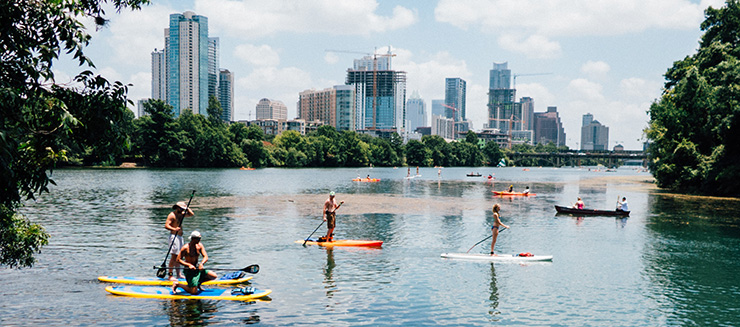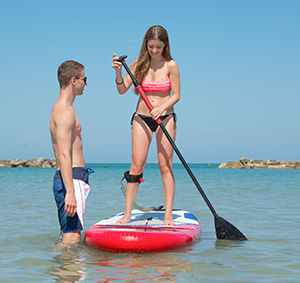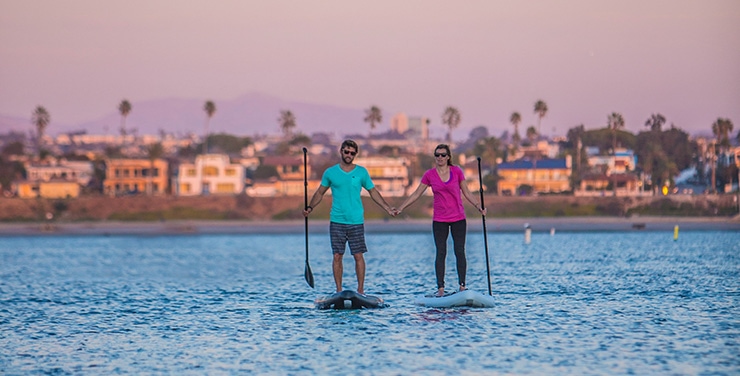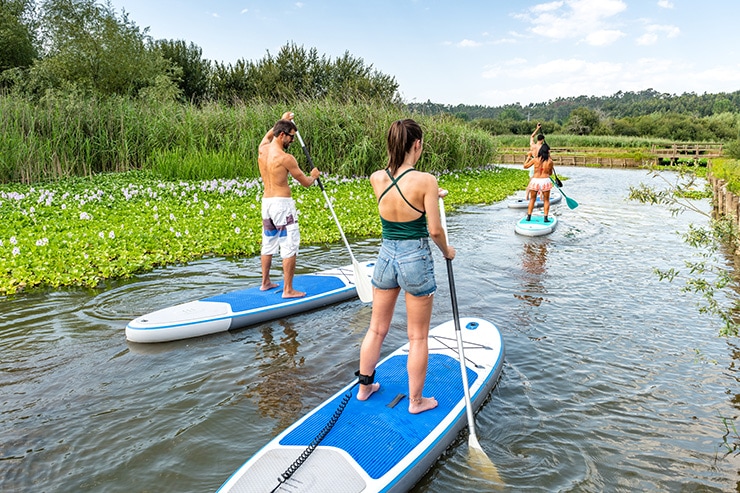The thought of paddle boarding is enticing for all adventure seekers, regardless of whether or not they know how to swim. Still, the question remains —can you paddle board if you can’t swim?
Simply put, if you practice basic safety tips and pick a body of water that is shallow enough, you can still paddle board even if you do not know how to swim (because if you’re in shallow enough water, you won’t have to).
Regardless of how skilled you are on a paddle board, if you can’t swim, then I wouldn’t recommend paddle boarding in water where you can’t stand up.
Today, I’ll share with you the basics of how to navigate paddle boarding as a non-swimmer. I’ll help you understand what type of water you should paddle board in, and what safety tips you should keep in mind as a paddle boarder who does not know how to swim (although you should still make water safety and learning to swim a top priority).
When Learning to Paddle Board, How Deep Should The Water Be for Non-Swimmers?
If you’re a paddle boarder who can’t swim, then the safest way to enjoy the sport is paddle boarding in shallow water.
It goes without saying that if you can’t swim, then you should avoid deep bodies of water. Even if you’re wearing a life vest, it’s not a safe practice to go out in deep waters if you don’t have any swimming skills or are a weak swimmer.
Getting back onto your paddle board when you fall can be tricky for beginners, and it can be an intimidating experience overall to try paddle boarding when your feet can’t touch the bottom. The safest method to practice on your stand up paddle board is in flat water that is on the shallow side, while wearing a personal floatation device.

Practice Paddle Boarding in Shallow Water
Shallow water is the best way to get acclimated to paddle boarding because you’ll feel that you have greater control every time you fall off your board.
It won’t be a scary experience when you fall and it’ll be easier for you to get back on your board (a skill all on its own). If you can’t swim, paddle boarding in shallow water is the perfect first step to helping you build your confidence while on the board. This confidence will allow you to build on your paddle boarding and swimming skills.
How Shallow is Too Shallow?
While shallow water is the recommended depth for first time paddle boarders and paddlers who can’t swim, you still want to paddle in deep enough water that you can perform proper strokes.
So, this means ankle deep water or even knee deep water is probably going to be too shallow. Instead, you should aim for the waist, or at the very least thigh high waters.
If you can’t swim, entering waters where you can’t touch the bottom while standing isn’t a great idea.
Also, since paddle boards have fins on the bottom, if the water is not deep enough, they can scrape against the bottom. This can damage your board.
You also need to make sure you’re paddling in deep enough water for your safety – if you fall off in ankle deep water, you can easily injure yourself. The danger is compounded if you’re paddling in an area that has rocks or tree branches.
Play It Safe with Waist Deep Water
Waist deep water is pretty much the sweet spot for non-swimmers to paddle. It eliminates the need to tread water if you fall off your board (since you can remain upright and standing).
Practicing balancing and paddling your SUP board in waist high water is also safer. You won’t hit the bottom of the body of water you’re paddling in and you minimize your risk of hitting your head or body on a sharp object like a rock.
You should still wear a life jacket, though, even if you’re paddling waist high waters. It’s important to feel safe on your board, and wearing a personal floatation device will help with this.
Avoid Water that Is Chest Deep (or Deeper)

As stated, if you can’t swim, you should avoid paddle boarding in water that is neck or even chest deep. Even if you’re wearing a life jacket, it’s dangerous to go paddle boarding in deep bodies of water when you don’t have swimming skills.
This goes for paddlers of all ages. Even if you’re accompanied by an experienced paddler who is a strong swimmer, you don’t want to paddle anywhere that could require you to tread water if you fall in.
Although the ability to tread water is one of the crucial skills you can have – it is not always possible. For weak swimmers, treading water can be difficult, and you can increase your chances of drowning if you panic.
Paddle Boarders Who Can’t Swim: Practice These Safety Tips
It’s important to practice paddle boarding safety, no matter your swimming skill level. If you can’t swim, it’s even more important, especially if your SUP experience is also minimal.
Aside from avoiding waters deeper than waist height, Here are necessary steps every stand up paddle boarder should take in order to maximize their safety when they’re out on the water
Wear a Life Jacket
It is imperative that you wear a life jacket or a personal floatation device that is suited for your size and weight when you go out paddle boarding. it’s actually against the law to go out on a paddle board without a PFD on board.
The United States Coast Guard details that paddlers age 12 and younger are required to wear a life vest. All other paddle borders do not have to wear a life vest but they should have it on board with them at all times.
If you’re a non-swimmer, then you should always wear your US Coast Guard approved life jacket no matter your age. A life jacket will help you keep your head above water when you fall off your paddle board.
Paddle Board With a Partner
Paddling with a partner can help you in the event you have an accident, can’t help yourself, or need some assistance.
If you’re new to paddle boarding and can’t swim, it’s especially important to bring along a partner who knows what they’re doing. At the very least, they can help you to get back to the water’s edge if you find yourself in trouble.

Boost Your Confidence and Take Swimming Lessons
Paddle boarders who can’t swim should make it a priority to take swimming lessons from a qualified instructor and at least learn the basics – such as how to tread water without the help of buoyancy aids.
Treading water is a crucial skill to master, as it helps you to stay upright, conserve energy, and keep your head above the surface – even without a life jacket.
Swimmers of all ages can benefit from techniques and tips taught in a swimming class. If you are going to participate in paddle boarding or any other type of water activity, it is highly recommended to enroll in a course to become a better swimmer.
If at all possible, look out for lessons that take place outdoors – so you can learn the difference between calm waters and deeper waters, and gain experience in different conditions.
Use a Stable Board
Most all rounder boards are stable enough for beginners to paddle, but you want to pay attention to the board specs and particularly the width. A wider board will generally be more stable and easier to balance on.
Balancing and keeping your body upright are crucial of you’re a beginner boarder, and almost as important for those who can’t swim (as it will help limit the amount of times you fall into the water).
Wider bases offer more surface area and allow you to have a wider stance when you’re on your SUP. Because of this, you’ll feel more stable and will be able to stay on your SUP for longer.
Most all rounder boards from reputable brands like Atoll or iRocker are worth considering for this reason.
Pick The Best Location for Your Abilities
Avoid rough rapids and fast rivers at all costs if you’re a non-swimmer, and make sure you’re not going anywhere with extreme temperatures. The best type of location to try will be calm, flat water that is shallow enough not to require you to tread water, and where the water temperature is not so cold that it causes issues.
Paddling on rough rapids will leave you falling off of your paddle board more times than you would like. Plus, you’ll spend more time chasing down your paddle board than you will actually enjoy time on it.
Carry The Right Safety Equipment
In addition to your PFD, you should carry the correct equipment with you to make your stand up paddling excursion safe. This means you need to attach your board with a leash, and also consider other safety gear like a GPS tracker for if anything should go wrong.
Final Thoughts
Having the right safety equipment, using a life jacket, and paddling in water that is waist deep are all ways you can stay safe on the water.
Above all, if you want to go stand up paddle boarding and become a strong swimmer, it’s imperative that you take lessons so that you can stay safe.

